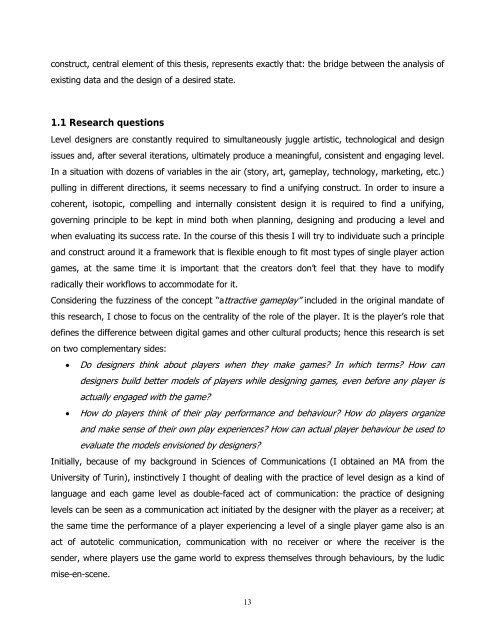Play-Persona: Modeling Player Behaviour in Computer Games
Play-Persona: Modeling Player Behaviour in Computer Games
Play-Persona: Modeling Player Behaviour in Computer Games
Create successful ePaper yourself
Turn your PDF publications into a flip-book with our unique Google optimized e-Paper software.
construct, central element of this thesis, represents exactly that: the bridge between the analysis of<br />
exist<strong>in</strong>g data and the design of a desired state.<br />
1.1 Research questions<br />
Level designers are constantly required to simultaneously juggle artistic, technological and design<br />
issues and, after several iterations, ultimately produce a mean<strong>in</strong>gful, consistent and engag<strong>in</strong>g level.<br />
In a situation with dozens of variables <strong>in</strong> the air (story, art, gameplay, technology, market<strong>in</strong>g, etc.)<br />
pull<strong>in</strong>g <strong>in</strong> different directions, it seems necessary to f<strong>in</strong>d a unify<strong>in</strong>g construct. In order to <strong>in</strong>sure a<br />
coherent, isotopic, compell<strong>in</strong>g and <strong>in</strong>ternally consistent design it is required to f<strong>in</strong>d a unify<strong>in</strong>g,<br />
govern<strong>in</strong>g pr<strong>in</strong>ciple to be kept <strong>in</strong> m<strong>in</strong>d both when plann<strong>in</strong>g, design<strong>in</strong>g and produc<strong>in</strong>g a level and<br />
when evaluat<strong>in</strong>g its success rate. In the course of this thesis I will try to <strong>in</strong>dividuate such a pr<strong>in</strong>ciple<br />
and construct around it a framework that is flexible enough to fit most types of s<strong>in</strong>gle player action<br />
games, at the same time it is important that the creators don’t feel that they have to modify<br />
radically their workflows to accommodate for it.<br />
Consider<strong>in</strong>g the fuzz<strong>in</strong>ess of the concept “attractive gameplay” <strong>in</strong>cluded <strong>in</strong> the orig<strong>in</strong>al mandate of<br />
this research, I chose to focus on the centrality of the role of the player. It is the player’s role that<br />
def<strong>in</strong>es the difference between digital games and other cultural products; hence this research is set<br />
on two complementary sides:<br />
• Do designers th<strong>in</strong>k about players when they make games? In which terms? How can<br />
designers build better models of players while design<strong>in</strong>g games, even before any player is<br />
actually engaged with the game?<br />
• How do players th<strong>in</strong>k of their play performance and behaviour? How do players organize<br />
and make sense of their own play experiences? How can actual player behaviour be used to<br />
evaluate the models envisioned by designers?<br />
Initially, because of my background <strong>in</strong> Sciences of Communications (I obta<strong>in</strong>ed an MA from the<br />
University of Tur<strong>in</strong>), <strong>in</strong>st<strong>in</strong>ctively I thought of deal<strong>in</strong>g with the practice of level design as a k<strong>in</strong>d of<br />
language and each game level as double-faced act of communication: the practice of design<strong>in</strong>g<br />
levels can be seen as a communication act <strong>in</strong>itiated by the designer with the player as a receiver; at<br />
the same time the performance of a player experienc<strong>in</strong>g a level of a s<strong>in</strong>gle player game also is an<br />
act of autotelic communication, communication with no receiver or where the receiver is the<br />
sender, where players use the game world to express themselves through behaviours, by the ludic<br />
mise-en-scene.<br />
13















